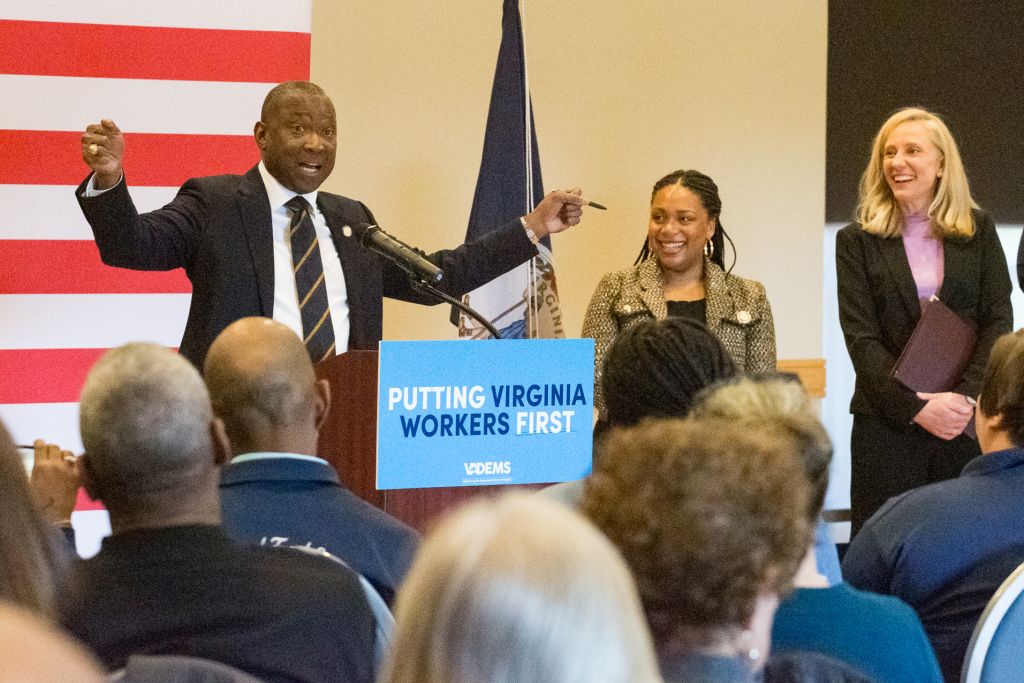Virginia Democrats Launch Surprise Redistricting Effort

The nationwide redistricting saga took a surprise turn on Thursday, Oct. 23, when Democratic legislators in Virginia announced they would begin a redistricting process of their own.
According to the Washington Post, House of Delegates Speaker Don Scott sent a letter to his colleagues informing them that a special legislative session to discuss redistricting will be held on Monday. While Democrats control both chambers of Virginia’s General Assembly, the redistricting effort has several barriers it must clear to prove successful. Both chambers of the state’s legislature must approve the legislation twice in two separate sessions due to an amendment in Virginia’s constitution.
Additionally, Virginia will hold a statewide election on Nov. 4, where all 100 seats in the state’s House of Delegates are on the ballot. Virginia Democrats must maintain control of the General Assembly during the election so that the measure passes in the second legislative session held after the election. Should the redistricting legislation clear those barriers, it will be sent to the voters in a statewide referendum held at least 90 days after its passage. The legislation must receive the majority of the vote to pass, which is the real wild card here.
Virginia is a true purple state, as it currently has a Republican governor and a state legislature controlled by Democrats. Additionally, Virginia voters approved a constitutional amendment in 2020 that gave control of redistricting to a bipartisan commission. There’s still uncertainty about how the proposed redistricting legislation would or wouldn’t involve the bipartisan redistricting committee. Should Virginia’s redistricting effort succeed, state Democrats are looking to add two to three new seats.
“Virginia’s decision to convene and preserve the right to consider a new map in 2026 is critical in the fight to ensure voters have fair representation, and we commend them for standing up against Republican attempts to weaken the power and vote of the people,” Courtney Rice, communications director for the Democratic Congressional Campaign Committee, said in a statement.
It should come as no surprise that Virginia Republicans are against the redistricting effort spearheaded by state Democrats. “Two-thirds of Virginians spoke loud and clear when they codified nonpartisan redistricting into our state Constitution five years ago,” Virginia’s Republican Gov. Glenn Youngkin said in a statement. “Twelve days before our statewide elections, this is a shameless, reprehensible political power grab by Democrat lawmakers.”
Terry Kilgore, minority leader in the state House, said that he and his Republican colleagues will use everything, legally, everything that we can do, to stop this power grab,” according to NBC News.
The ongoing redistricting saga is extraordinary in that redistricting historically only happens every 10 years. This all started in July when President Donald Trump asked Texas Gov. Greg Abbott to launch a mid-decade redistricting effort to help protect the GOP’s narrow majority in the House. Before the redistricting effort began, Democrats only needed a net gain of three seats to flip control of the House.
Gov. Abbott went along with Trump’s request and used the devastating Kerr County floods as an excuse to call a special legislative session. Texas Democrats were shocked to find that the session primarily focused on redistricting as opposed to flood relief, and did their best to fight back. They filibustered, fled the state to break quorum, and at one point, Rep. Nicole Collier was held political prisoner on the state House floor after refusing to agree to police surveillance upon returning to the state. Ultimately, the Texas state legislature passed a new map that adds five new House seats in districts Trump won during the 2024 election.
President Donald Trump has spent the last four months pressuring states like Indiana, Florida, Missouri, and North Carolina to begin redistricting efforts of their own. Missouri and North Carolina have both implemented new maps that potentially add one new House seat for Republicans in both states. Florida formed a committee to discuss a potential redistricting effort, while the redistricting effort in Indiana has stalled out.
By and large, most Blue states have independent redistricting committees and have quite a bit of legal red tape preventing them from launching redistricting efforts to counter the GOP. While California has an independent redistricting committee, Gov. Gavin Newsom announced the “Election Rigging Response Act” in August.
The act added Prop 50 to the California ballot for the Nov. 4 special election. If voters approve Prop 50, control of California’s congressional maps will temporarily transfer from the independent redistricting committee to the state legislature until 2030. Gov. Newsom intends to implement a congressional map that directly neutralizes the gains made in Texas should Prop 50 succeed in the election. With early voting numbers breaking records and Democrats largely in favor of Prop 50, California could make it happen.
As Illinois and Maryland remain noncommittal about launching their own redistricting efforts, it seemed that hopes of combating the GOP’s gerrymandering scheme rested solely with California. With Virginia entering the fray, the math is slowly but surely beginning to equalize. One can only hope that Illinois and Maryland pull the trigger on their own redistricting efforts. While California will likely neutralize Texas, and Virginia will likely cancel out North Carolina and Missouri’s gains should their effort prove successful, Florida is still a looming threat in the redistricting battle.
SEE ALSO:
North Carolina’s GOP State Legislature Passes Gerrymandered Map
President Trump Eyes Florida And Indiana In Redistricting Push



